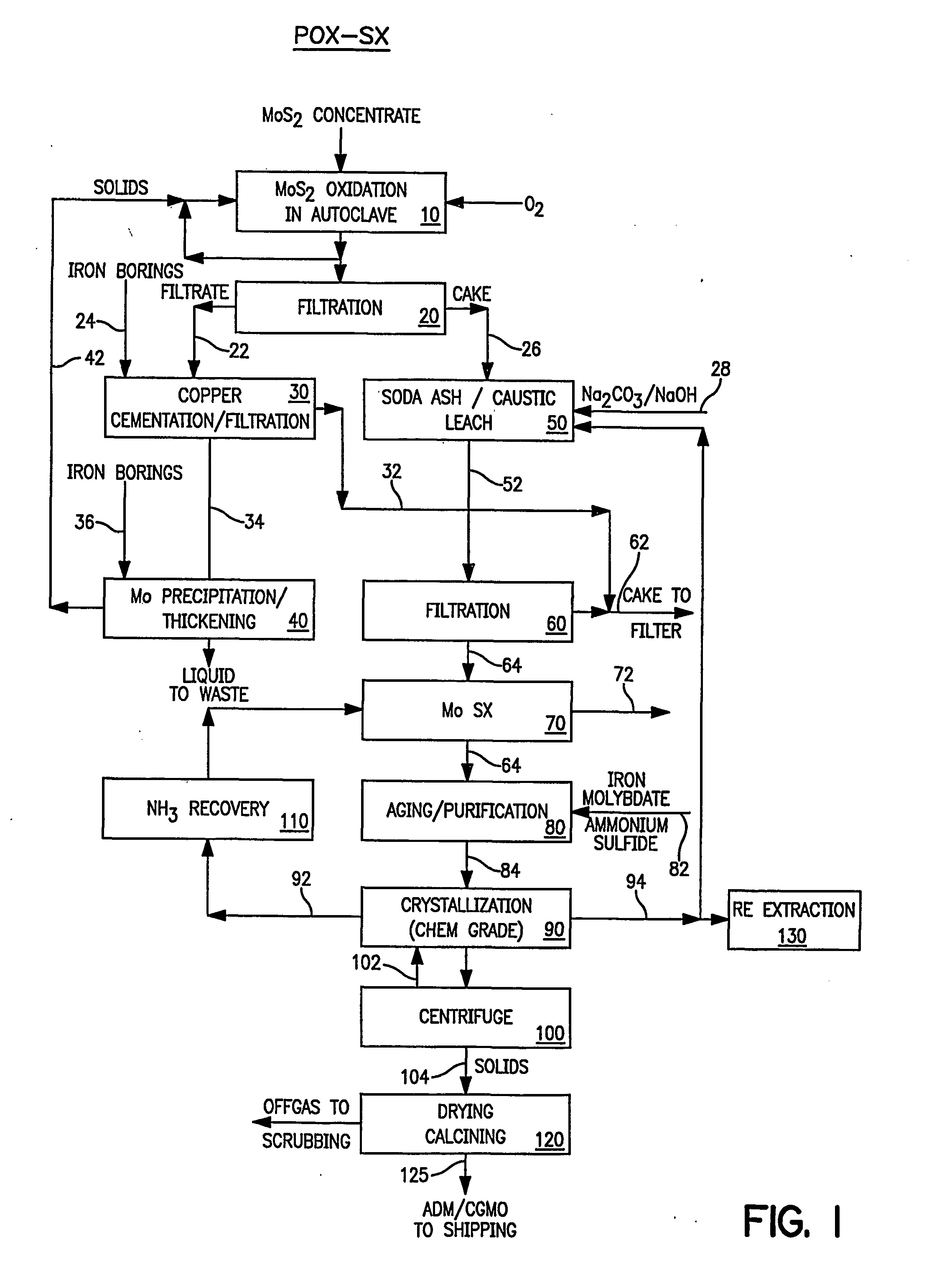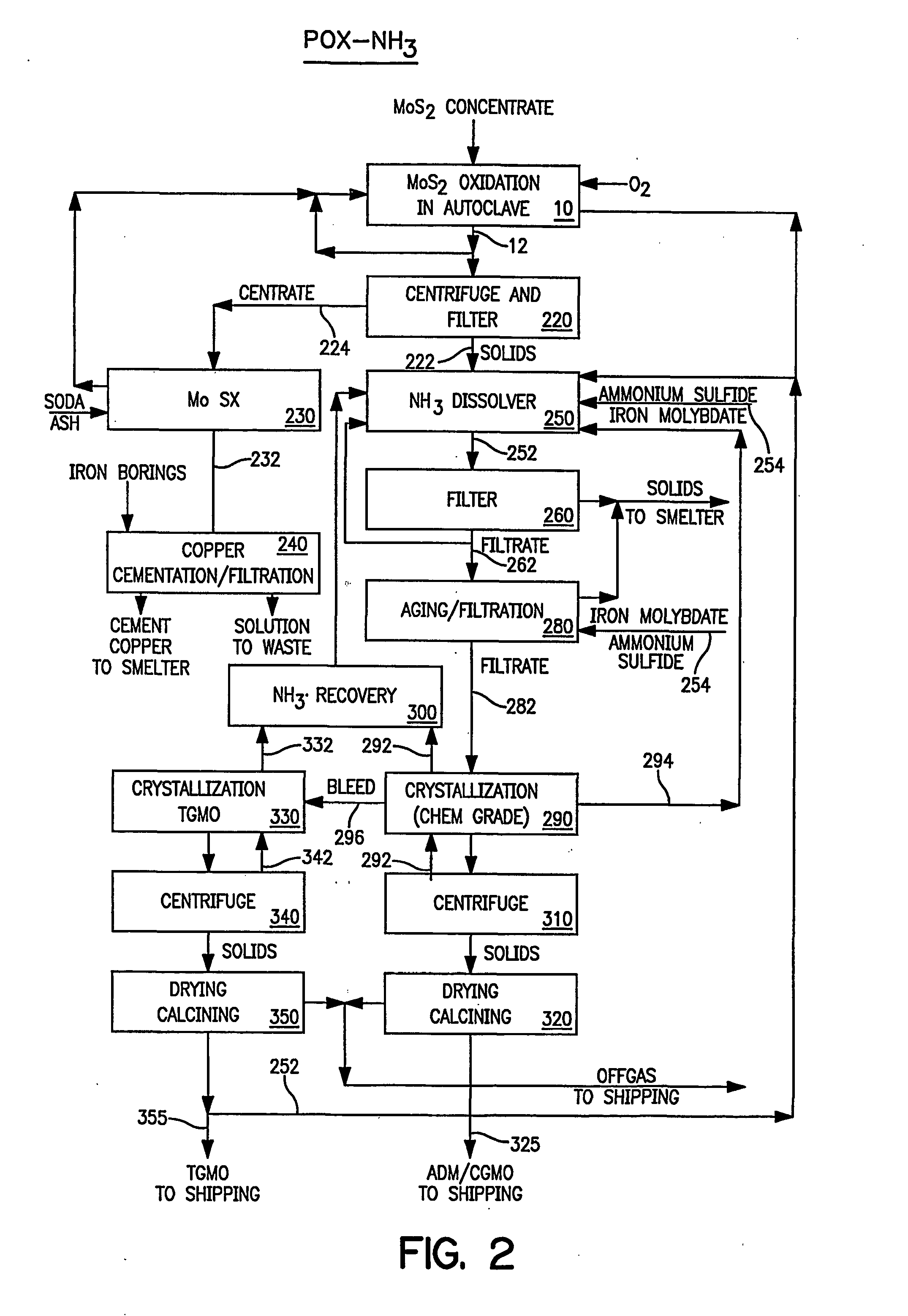Production of pure molybdenum oxide from low grade molybdenite concentrates
a technology of molybdenum oxide and molybdenum oxide, which is applied in the direction of molybdeum compounds, chemistry apparatus and processes, and ozone/oxide/hydroxide, etc., can solve the problems of preventing the formation of protective layers, preventing and limiting the use of commercial circuits. achieve the effect of maximizing the insoluble molybdenum value and high purity
- Summary
- Abstract
- Description
- Claims
- Application Information
AI Technical Summary
Benefits of technology
Problems solved by technology
Method used
Image
Examples
example 1
After pressure oxidation of the molybdenite concentrate in the autoclave and the solid-liquid separation of the slurry, the resulting acidic liquid is treated by cementation. The major constituents of the liquid are approximately: Mo, g / l 10-16 Cu, g / l 8-11 Fe, g / l 8-11 H2SO4, g / l 100
The cementation process is conducted at room temperature and begins by adding to the liquid about 1.0 gram Fe per gram Fe present (as Fe3+) in the liquid and about 2.0 gram Fe per gram Cu present in the liquid. The slurry is mixed for 10-15 minutes and then filtered. The solids contain the recovered Cu-values. The filtrate is then treated for the recovery of Mo.
The pH of the filtrate is increased to about 1.05-1.2 by the addition of Na2CO3 or NaOH and the temperature of the filtrate is increased to about 40-65° C. An additional 1.5-2.1 gram Fe per gram Mo present in the liquid is then added. The slurry is mixed for 15-30 minutes and filtered. The filtrate should have a clea...
example 2
Alkaline Leach
A number of tests were performed to attempt optimization of the leaching conditions while minimizing the formation of bicarbonates. The alkaline leaching data are summarized in Table 3. Leaching at pH values below 7.0 using sodium carbonate demonstrated almost complete solubilization of the molybdenum but significant co-solubilization of iron, probably as a carbonate complex, was also present. Leaching with sodium hydroxide did not solubilize much iron. Therefore, tests to optimize leaching cost and efficiency evaluated an initial leach with sodium carbonate to 6 pH, followed by sodium hydroxide to 9 pH or only using sodium hydroxide. Molybdenum extraction in these tests (see Table 3, Leach No. CL-1 to CL-6) exceeded 98%. The leach solutions contained 43 to 79 g / l Mo and silicon was the only impurity of significance. The reagent requirement averaged about 1.1 lb Na2CO3 and 0.7 lb NaOH per lb of molybdenum dissolved.
example 3
Alkaline Leach Solvent Extraction
A number of tests were performed to determine the optimum conditions for solvent extracting molybdenum from the alkaline leach solutions. The molybdenum solvent extraction studies used an organic containing 10% di, tridecyl amine, 5% decyl alcohol, and 85% Escaid 110. The results of these studies are summarized in Tables 4A-4C. The initial tests evaluated the effect of temperature in the pH range of 2.0-2.7. Temperature had no significant effect on the molybdenum extraction. The extraction was very efficient with raffinates containing from 1 to 40 mg molybdenum / liter from feed solutions containing 63 to 70 g / l (greater than 99.9% transfer). The distribution coefficients in the first contact,
TABLE 3ALKALINE LEACHING OF POX LEACH RESIDUE MOLYBDENUMEXTRACTION AND LEACH SOLUTION IMPURITIESDissolutionLeachTempNa2CO3NaOHSolubleNa2CO3NaOHFiltrateFiltrate Impurities, mg / l on a 200 g / l Mo basisNo.:° C.to ? pHto ? pHMog / g Mog / g MoMo, g / lCuFeAsKPReMgSiSeRL...
PUM
| Property | Measurement | Unit |
|---|---|---|
| temperature | aaaaa | aaaaa |
| temperature | aaaaa | aaaaa |
| flash point | aaaaa | aaaaa |
Abstract
Description
Claims
Application Information
 Login to View More
Login to View More - R&D
- Intellectual Property
- Life Sciences
- Materials
- Tech Scout
- Unparalleled Data Quality
- Higher Quality Content
- 60% Fewer Hallucinations
Browse by: Latest US Patents, China's latest patents, Technical Efficacy Thesaurus, Application Domain, Technology Topic, Popular Technical Reports.
© 2025 PatSnap. All rights reserved.Legal|Privacy policy|Modern Slavery Act Transparency Statement|Sitemap|About US| Contact US: help@patsnap.com



